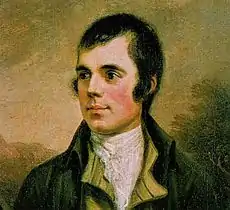Adam Armour
Adam Armour (1771-1823) was the younger brother of Jean Armour and therefore the brother-in-law of the poet Robert Burns. In addition, being married to Fanny (Frances) Burnes, he was also related to the poet through his father-in-law (Robert Burnes) 'Poor Uncle Robert', who lived at Stewarton.
Adam Armour | |
|---|---|
| Born | 27 February 1771[1] Mauchline |
| Died | 8 January 1823 |
| Occupation | Builder |
Life and background
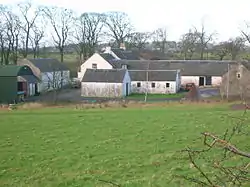
Baptised on 3 March 1771 at Mauchline Adam was a builder, as was his father, the master mason James Armour (15 January 1731 – 25 September 1798), father-in-law of the poet Robert Burns.[2] His mother was Mary Smith (Died 30 July 1805) who married at Mauchline on 7 December 1761 and his siblings were John Armour, Jean (Armour) Burns, James Armour, Robert Armour, Helen Armour, Mary Armour, Robert Armour, Mary Armour, Janet Armour and Robert Armour.[1] He is thought to have been of small stature, alluded to by Burns in "Adam Armour's Prayer" where he has Adam say "Gude pity me, because I'm little!"[3] His portrait is listed in 1962 as being in the National Burns Tower Museum in Mauchline. Adam was named for Adam Smith, James Armour's father-in-law.[4]
Family
Adam met Fanny Burnes at Ellisland Farm as her cousin Robert Burns had taken her and her brothers in after the death of her father Robert in 1789. Adam was for a time employed at the nearby Dalswinton House as a builder, lodging at Ellisland with his sister and brother-in-law and therefore sharing the house with Fanny amongst others.[2][5]
On 5 June 1792[6] Adam is said to have married Fanny at Dalswinton that lies near Ellisland, however the wedding is also said to have taken place at Mauchline.[6][7] The couple had nine children, James (b. 16 Mar 1793, d. 29 Jan 1816), Jean (b. 4 Dec 1794, d. 22 Oct 1796), Robert (b. 15 Mar 1799, d. 6 Mar 1849), Fanny (b. 8 Jan 1801), Adam (b. 9 Mar 1803), Mary Smith (b. 15 Oct 1805), John (24 Dec 1807, d. 14 Jun 1809) and William (b. 25 Jan 1812, d. c 1859).[8] Adam died on 8 January 1823 aged 51.[2]
Association with Robert Burns
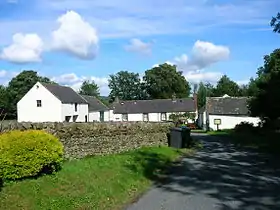
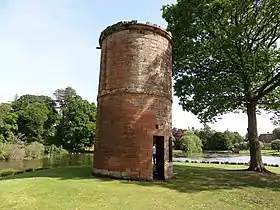
It was Adam who was sent to Mossgiel to inform Robert that his sister Jean had given birth to the poet's son and daughter, named after the parents through the Kirk Session protocol for children born out of wedlock.[9] It was said that Adam found Burns working at the plough however the day being a Sunday this is highly unlikely.[10]
When the poet's Uncle Robert died he did what he could to help John, William and Fanny (Frances) Burnes, his cousins, to gain employment. In February 1789 Robert Burns wrote from Ellisland Farm to his cousin, James Burnes in Montrose from Ellisland, saying: "We have lost poor uncle Robert this winter .... His only daughter, Fanny, has been with me ever since her father's death and I purpose to keep her in my family til she be quite woman grown, and be fit for better service. She is one of the cleverest girls, and has one of the most amiable dispositions, that I have ever seen." [6] Both John and Fanny lived with the Burns family for a time from 1789 at Ellisland Farm.[7]
Robert paid Adam six shillings in November 1791 to return to Ellisland at the dead of night to smash every window in the farm upon which he had inscribed verses as an act of revenge upon James Morin, Laird of Laggan who was the new owner. Robert felt cheated over the price paid for a heap of manure, a valuable commodity before artificial fertilisers were available. No record of the verses has survived.[11][12] Adam carried out the task and in 1813 he related the incident to a Dumfriesshire man.[5] Adam Armour and Fanny Burnes's signatures were on a window pane in the southern window of the parlour and a favourite quote from Alexander Pope "An honest man's the noblest work of God." in what may have been Burns's handwriting.[5] A record survives of the charges placed upon Burns for 'dilapidations' at Ellisland and is for 'Glass' six shillings![13]
The Agnes Wilson incident
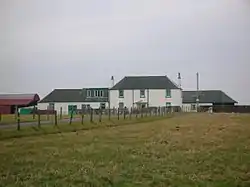
Agnes Wilson was a female servant or journeywoman who worked for George Simpson, the landlord of Poosie Nancie's. She had a reputation as a prostitute and Adam Armour at the age of 15[14] led a group of 'Auld Licht' adherents who decided to run her out of town. The gang obtained a rough pine tree pole, suspended it between horses and forced her to sit astride it. The experience caused her significant physical injury as Burns' poem describes. George (Geordie) Simpson and his wife Agnes (Poosie Nancie) greatly resented this cruel and lawless behaviour and proceeded to prosecute Adam and his group.[3] The Kirk Session noted the disturbance on 6 March 1786.[14]
Following this breach of the peace, and while evading arrest, Adam met Burns, and asked for his advice. Burns is said to have suggested that he would be best to find someone to pray for him, and Adam to have replied: "Just do't yoursel, Burns, I know no one so fit." Adam asked if he could lie low at Mossgiel until the situation calmed down and Burns agreed. It was on this occasion that Burns discovered from Adam that his sister, Jean Armour, had been sent to stay with an uncle in Paisley.[15]
As a result of the affair Burns wrote 'The Prayer' or 'Adam Armours Prayer' that, although well known in Mauchline was not published until 1808 when it appeared in the Edinburgh Magazine.[3] It was a prelude to Holy Willie's Prayer.
"Adam Armour's Prayer" By Robert Burns
|
"Gude pity me, because I'm little! An' now Thou kens our waefu' case; An' now we're dern'd in dens and hollows, Auld grim black-bearded Geordie's sel', When Death comes in wi' glimmerin blink, Though Jock an' hav'rel Jean are merry, As for the jurr-puir worthless body! |
This incident is related to the "Court of Equity" of which Burns was a member that in 1785 and 1786 met at the vinter John Dow's house in Mauchline where they debated the cases of scandal taking place in the village and -
|
"To punish contravening truants |
Burns has Adam state in his poem that Agnes Brown would have been hung had she been caught acting again as a prostitute.[17]
See also
References
- Notes
- Westwood (1997), Page 34
- Westwood (2008), Page 28
- Douglas, Page 294
- Boyle (1996), Page 63
- Mackay, Page 446
- Purdie, Page 56
- Mackay, Page 450
- Burness Genealogy and Family History
- Hogg, Page 102
- Mackay, Page 194
- Hogg, Page 230
- McQueen
- Duncan, Robert (1910). The Story of the Edinburgh Burns Relics with Fresh Facts about Burns and his Family. Andrew Elliot. p. 40.
- Mackay, Page 179
- Hosie
- "Robert Burns Country". Retrieved 23 January 2018.
- Noble & Hogg, Page 599
- Sources and further reading
- Annandale, Charles (Editor) (1890). The Works of Robert Burns. London : Blackie & Son.
- Barclay, Alastair (1989). The Bonnet Toun. The Stewarton Bonnet Guild.
- Boyle, A. M. (1996), The Ayrshire Book of Burns-Lore. Darvel : Alloway Publishing. ISBN 0-907526-71-3.
- Dougall, Charles E. (1911). The Burns Country. London : Adam and Charles Black.
- Douglas, William Scott (1938). The Kilmarnock Edition of the Poetical Works of Robert Burns. Glasgow : Scottish Daily Express.
- Hogg, Patrick Scott (2008). Robert Burns. The Patriot Bard. Edinburgh : Mainstream Publishing. ISBN 978-1-84596-412-2.
- Hosie, Bronwen (2010). Robert Burns. Bard of Scotland. Glendaruel : Argyll Publishing. ISBN 978-1-906134-96-9.
- Jackson, J. R. (1996). Can You Help Find "Poor Uncle Robert". Burns Chronicle. Bicentenary Edition.
- Mackay, James. A Biography of Robert Burns. Edinburgh : Mainstream Publishing. ISBN 1-85158-462-5.
- McNaught, Duncan (1912). Kilmaurs Parish & Burgh. Paisley : Alexander Gardner.
- McQueen, Colin Hunter & Hunter, Douglas (2008). Hunter's Illustrated History of the Family, Friends and Contemporaries of Robert Burns. Published by Messrs Hunter Queen and Hunter. ISBN 978-0-9559732-0-8
- Noble, Andrew and Hogg, Patrick Scott (Editors). (2001). The Canongate Burns. Edinburgh : Canongate Books Ltd. ISBN 1-84195-148-X
- Purdie, David; McCue Kirsteen and Carruthers, Gerrard. (2013). Maurice Lindsay's The Burns Encyclopaedia. London : Robert Hale. ISBN 978-0-7090-9194-3.
- Strawhorn, John Letters from a Land Steward. Was he 'Poor Uncle Robert'. Annual Burns Chronicle & Club Directory.
- Westwood, peter J. (1997). Genealogical Charts of the Family of Robert Burns. Kilmarnock : The Burns Federation.
- Westwood, Peter J. (2004). The Definitive Illustrated Companion to Robert Burns. Scottish Museums Council.
- Westwood, Peter J. (Editor). (2008). Who's Who in the World of Robert Burns. Robert Burns World Federation. ISBN 978-1-899316-98-4
